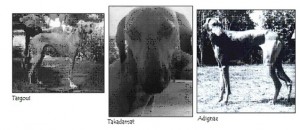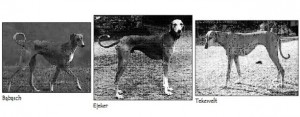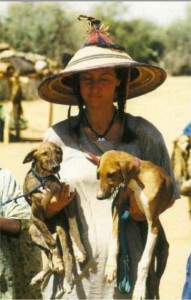MVDr. Gabriele Meissen: Back from the Precipice
Though the focus of this article is a pressing current issue, a brief history of the breeding of Azawakh in Europe is in order--beginning with the first importations from Mali, Niger, and Burkina Faso. Outlining this history will help to clarify and reinforce the need for, and benefits of, the continuing use of desert-bred Azawakh in western breeding programs. It should be well known by now that the breeding of Azawakh in Europe began with very few specimens. Between 1972 and 1978 a total of five Azawakh were either imported into France or used for breeding by returning civil servants from what was then French Colonial West Africa: the bitch TOBORO II (imported by Parigi) and the dogs AIKAR, AOURAKH, ADIGNAZ and TARGOUI. Not all the dogs were imported directly into France. TOBORO II herself was imported earlier, but some of the matings took place between 1972 and 1978 when Parigi bred TOBORO II in Mali and returned to France with her in whelp. What would come to be known as the French Line began with TOBORO II's production of four litters, one by each of the four dogs. In essence, a line was started through crossing half-siblings. Half its genetic 'base' was one Azawakh bitch.

In 1975 Francois Roussel imported the desert-bred bitch TAHOURA. TAHOURA was bred to Ouleda (TOBORO II x AIKAR) and from the resulting litter the dog Azeraf was later introduced into European breeding programs. Kaola, a daughter of TOBORO II (X ADIGNAZ) was bred in 1979 to the desert-bred TAKADAMAT. From this mating the bitch Pegga resulted, who in turn whelped the well-known sire Timgad, who today can be found in the ancestry of almost every living western-bred Azawakh. As can be seen, the French line was based on only seven desert-bred Azawakh. The line was carried forward from a genetic base that was extremely small, its future compromised by the fact that only two of the seven were bitches. The genetic base of the Yugoslavian Line was even more compromised. It was founded on only three desert-bred Azawakh: one bitch, LARA, and two dogs, GAO and DARKOYE SIDI.

Dr. Pecar, a Yugoslavian diplomat stationed in Mali, imported GAO and LARA from the region of Menaka in the Azawakh Valley to Yugoslavia and began breeding them. These importations were contemporary to the first importations to France. All told, GAO sired nine litters, seven of these after being mated to his direct descendants. In 1976, DARKOYE SIDI was imported from the province of Oudalan, Burkina Faso. By today’s western standards DARKOYE SIDI would be considered a dog of very rustic type. Anyone importing a dog of this type today (at least in Europe) would face challenges in obtaining permission for breeding. However, DARKOYE SIDI sired eight litters out of bitches descending from GAO and LARA as well as out of his own descendants or bitches closely related to him, in Yugoslavia, Czechoslovakia and Germany. The breeding of Azawakh in Switzerland and Poland also started from this base.

From the beginning, with both lines, very close inbreeding was inevitable. Such inbreeding is defined as the mating of individuals sharing extremely close degrees of relationship, such as full or half-siblings, or parents and their direct offspring. Unfortunately for the Azawakh race in the west, this inbreeding resulted in a very rapid impoverishment of the genetic base of the breeding population; almost dizzying inbreeding coefficients, in some cases as high as 40%, and high ancestral loss were two immediate and direct results of an unavoidable breeding strategy.

Inbreeding depression was clearly adversely affecting the dogs, evidenced by a reduction in vitality, fertility and performance. With uninterrupted inbreeding, each generation of offspring displayed increased homogeneity, in both phenotype and genotype. But with this increase in homogeneity came the risk of defective genes (i.e. genes responsible for the occurrence of hereditary diseases) meeting, leading to an increased probability of genetic disorders. The most unfortunate example was the Yugoslavian line, where many specimens suffered from idiopathic epilepsy. With each increasing degree of inbreeding from generation to generation, the frequency of occurrence of epilepsy increased as well.
Such close inbreeding and line breeding also produced a change in both type (increased refinement which implied an increase in nobility) and anatomy. The changes in anatomy were typical and negative: common examples were extremely narrow fronts, fragile bones, weak joints, hackneyed movement, and shortened ribs. Add to this list missing teeth, undescended testicles in the dogs, and dogs lacking in masculinity, and the picture is clear.
Years passed. Finally some breeders faced reality: breeding forward with the two lines distinct but unrelated and isolated, was untenable. These breeders, including owners of the German Kennel Aulad al Sahra, began to cross specimens from the two lines. The results were an immediate decrease in the degree of inbreeding combined with an overall increase in health. However, one important coefficient did not change: ancestral loss. And, since soon closely related dogs were again to be mated, the positive results of the crossing of the two lines were understandably short-lived.
More years passed and finally, in the mid-80s, three more desert-breds were imported into France by Gervais Coppe: the dogs EJEKER and BABASH and the bitch TEKEWELT. The Coppe´s founded the kennel Kel Tarbanassen to which they later added the European-bred bitch Cenerentola de Nomades Bleus. Specimens from their breeding program would come to exert a profound influence on the breeding of Azawakh in the west, and today Azawakh from Coppe´s breeding are found in a vast majority of western pedigrees: Firhoun, Guerwane, Geurougeurou, Farah… to name only a few.
If one adds the three Coppe desert-bred imports, we can say that the race in the west was created from thirteen foundation specimens. Anyone with even the slightest idea of modern genetics would have to agree that, as a base for the creation of a healthy breeding population, this number was woefully insufficient.
Were it not for the addition over the past twenty years of desert-bred specimens imported from the region of origin, breeding of Azawakh could not have continued in good conscience. The fact remains that all Azawakh in the west are intimately related, a fact perhaps not immediately obvious to a casual observer. The generations have progressed, a few out-crosses have been used, but look further back in the pedigrees and it is obvious that all western-bred Azawakh share the same ancestors. Again, without the addition of fresh desert-bred stock to western breeding program in the last two decades, breeding forward would have been next to impossible. To say these additions happened just in time would be an understatement.
The impoverishment of the genetic base was further exacerbated by the multiple-use of particularly popular sires during mid-nineties. These Super Sires, extremely successful show dogs, each of a unique type and prepotent in the sense that each stamped his descendants with his type, changed the course of Azawakh breeding in the west. Three prime examples are Kel Tarbanassen Firhoun (sire of 12 litters), and the full brothers Gefell and Greboun de Garde Epee who each sired 10 litters. Simply note that these males were either full brothers or closely related (i.e. cousins), and that each year only a few litters are born in the west, and one sees the classic genetic bottleneck. Its consequence: the loss of future genetic and phenotypic variance.
This brief history of Azawakh breeding should be evidence enough that increased and continuous inclusion of desert-bred specimens imported from their region of origin is absolutely essential. The genetic base must be supplemented to guarantee the future of the Azawakh in the west.
Fortunately, desert-bred specimens have been incorporated into several western breeding programs since the early nineties. Even in France, the patron country of the Azawakh, several kennels have used desert-bred specimens and their offspring, though these efforts have been met with resistance. Since the desert-bred Azawakh are predominantly of a different type than the type designed to win in western show rings, one must see their addition to the gene pool as an enrichment and assurance of the future: there is no need for them to prove themselves in competition against the modern show dogs. But there are roadblocks. For example, in Germany it is forbidden to mate two desert-breds together. Fortunately in other countries there is no such restriction and as an example of the positive results possible from matings I have provided an image of Takama, bred by Corine Lundquist, owner of the French kennel Azawakh de Garde Epee, daughter of the dog RAMSES and the bitch TAIRA, both desert-bred specimens.
A sampling of some of the desert-bred specimens used for breeding in the past two decades are: DAZOL IN CHENAN, YARIS and BIYANOU (imported by Ursula Arnold); AZABOR, TAIKOUSSOU AK INTANGOUM, AMANAR, TAINOSS, HATSHEPSUT, TAYTOK, AURAK INJAKOK, KELA, SIKARA, TIGIDIT, AGAROUF, DJANGO, ANZA LAYLA, TAUSSIT KEL DINNIK, TAMAHAN and TIRAOUT (all imported by ABIS and used in various western breeding programs); SALOME, AIKAR and AKCHI (imported by Elisabeth Eiles and Hans-Jürgen Stassner), E´CHIPIE MENAKA and more recently the aforementioned RAMSES and TAIRA (used by Corine Lundquist).
Of course since the type cultivated in the west is in many cases very far from its roots and firmly established in the western consciousness as the Azawakh, there has been controversy regarding the relative quality of the recent imports. One must ask oneself if the specimens bred in the west, without the infusion of fresh desert-bred stock, are perfect.
Here we come to the point where it is necessary to demystify the romanticized creation legend of the Azawakh: that the ten original specimens imported to Europe were last surviving specimens of an incredibly noble race of sighthounds bred by the incredibly noble Blue Lords of the Desert, isolated in time and history in some mysterious, deep corner of the Azawakh Valley of Mali (the race in the west is named for this valley); essentially that only specimens descending from these original ten were purebred. By default all other dogs in the Sahel were impure and not to be considered for inclusion in any purist breeding program. Fortunately fifteen annual expeditions to the race’s region of origin have debunked this myth (though a few breeders still hold out hope!). The empirical research, evidenced by thousands of photos and film footage taken over the last 15 years by ABIS contradict the ridiculous if beautifully colored legend. One hopes it has been safely assigned its appropriate place within the realm of myth.
No doubt desert-bred specimens of noble type were among the first imports, just as in the present. But rustic radical representatives, such as DARKOYE SIDI or later BABASCH, were also present. It is highly likely that today they would be considered inferior to the majority of recently imported desert-bred specimens. Nevertheless, breeding forward from them has been both rewarding and essential.
If one needs further proof of the quality of the recent desert-bred imports, there is ample evidence to be found in both the show ring and performance venues. The desert-bred MALI (a dog imported from Mali by Rudolf Caster in 1982) was German Champion. YARIS (a desert-bred dog imported from Niger in 1984 by Ursula and Reinhard Arnold) was German Champion and Regional Winner NRW in 1986 and 1987. He ran successfully on the racetrack and was awarded the German Performance Certificate. In 1986, DAZOL IN CHENAN (a desert-bred bitch imported from Mali, also by the Arnolds) was German Champion, in 1988 International Derby Winner, and in 1991 was awarded the Short Distance Racing and Performance Certificate. Akchi (a bitch imported from Mali in 1986 by Elisabeth Eiles and Hans-Jürgen Stassner) was German Champion. AIKAR ELKOR (a dog also imported by Eiles and Stassner in 1987) was German and Austrian Champion. In 1989 the imported bitch SALOME was German Champion, VDH Champion and during her life won numerous Regional Champion titles. SALOME was founding bitch of the kennel Kel Tin-Hinan, Germany.
From 1993 ABIS Expedition TAIKOUSSOU AG INTANGOUM (a desert-bred bitch imported by Werner Roeder, Azawakh Of Silverdale, Germany, from well-known Sahelian breeder Ayad ag Inachanan in Burkina Faso), already a German Champion, was the Veteran Class Winner in the Azawakh Specialty. She won against stiff competition against a large showing 40 bitches in six classes (6x puppy Class, 2x Junior Class, 17x Open Class, 6x Working Class, 6x Champion Class, 3x Veteran Class). Furthermore she was a VDH Champion and Regional Champion Bayern in 1995. TAYTOK, a bitch imported from Mali by ABIS during the 2000 expedition, was the first desert-bred Azawakh to receive the title of Champion of Beauty and Performance. She has produced three litters for me.
In 1995 the desert-bred dog AZABOR, (another Azawakh bred by Ayad ag Inachanan in Burkina Faso) imported by ABIS, proved his outstanding athleticism. From 12 races he finished first 9 times, twice won the title Landesrennsieger Berlin-Brandenburg and ran 480 meters in sensational time of 33.70 seconds. He sired the C-litter of Christiane Thier-Rostaing, Agg Amaias Azawakh, Germany). From the 1997 ABIS expedition, Alberto Rossi imported the desert-bred dog TIGIDIT. Rossi named his kennel after his beloved TIGIDIT who in addition to winning the European Coursing Championship in 2002, sired three litters.
Upon close inspection one simply cannot fail to notice how, breeding forward from even the most rustic desert-bred specimens, Azawakh of excellent type and athleticism can be produced. It requires a rapid generational turnover combined with a breeder’s talent and vision. It would be beyond the scope of this article to list the successes of the first and second generation crosses to the desert-bred specimens, though they deserve to note.
In closing I want to say that the continued use of desert bred Azawakh imported from their region of origin is imperative to get our race onto a better footing, both as regards health and type. The current FCI standard of the Azawakh, even if to expand the allowable colors and markings, still fails to provide sufficient breeding options. It should be possible, despite differing opinions on the genetic and phenotypic situation, for breeders to co-exist, working side by side to breed for the future of the race.
Breeding for me means to think in generations, not just the next litter. And it is my hope that more breeders in the west become focused on the preservation of the race, they will realize the long-term benefits of using desert-bred stock in their breeding programs. Such inclusion, if not encouraged by powers-that-be, should at least not be blocked. Surely the Azawakh deserve this chance.
________________________________________________________________


Gabriele Meissen is a Doctor of Veterinary Medicine currently practicing small animal veterinary medicine near Munich, Germany. Dr. Meissen was a member of two ABIS Expeditions in 1996/97. She has published several important articles, one of which was COLOR, PATTERN AND MARKINGS OF THE AZAWAKH IN THEIR REGION OF ORIGIN. Dr. Meissen strives to preserve the authentic Azawakh by breeding correct specimens of elegant or extreme expression type. She is pictured above with her first Azawakh Al-Hara´s Jaba and Jaba´s daughter Tobol (x Ahod).
She is the owner of the well-known kennel Tombouktou´s Azawakhs.




